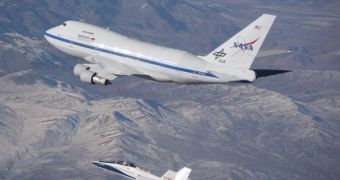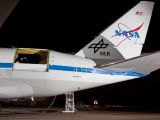Yesterday, NASA reached an important milestone in its development of the first airborne infrared telescope, dubbed SOFIA. Mounted on the side of Boeing airplane, the telescope's main advantage is that it can be deployed anywhere it is needed. Its powerful instruments allow for scientific observations to be conducted from places that are not usually fitted for astronomical observations, but which become suited through a fortunate chain of events.
An example would be regions that are usually cloudy, and therefore do not allow for the construction of a permanent telescope on the ground. But, even these areas experience a few sunny days each month, and they offer clear vantage points of the sky above. During these days, SOFIA could fly overhead, scouting the sky in infrared wavelengths, and collected new pertinent scientific data.
The Stratospheric Observatory for Infrared Astronomy now sits aboard a modified Boeing 747. Even though it took its first flight in 2007, the scientific instrument was flight tested for the first time in its final configuration yesterday. This involved the doors protecting the actual telescope being opened, and the instrument itself exposed. SOFIA flew for one hour and 19 minute, NASA says in an official press release, during which time a number of systems were analyzed and checked. In addition to the issues related to the device itself, engineers at the space agency got a chance to look at how air flows in and around the telescope, and at what effects this causes.
“Today we opened the telescope cavity door, the first time we have fully exposed the telescope and the largest cavity ever flown while in flight. This is a significant step toward certifying NASA's next great observatory for future study of the Universe,” says NASA Dryden Flight Research Center expert and SOFIA program manager, Bob Meyer. Two additional test flights, whose goal will be to analyze the scientific capabilities of the observatory, will be conducted in spring 2010, the expert adds. Later in the year, the aircraft and its telescope are scheduled to begin their full-time science mission.
SOFIA is actually a collaboration between the American space agency and the German Aerospace Center DLR. The modified Boeing 747 was provided by NASA, while the actual telescope was constructed in Germany. The aircraft is based at the Dryden Aircraft Operations Facility, in Palmdale, California, but the scientific program is managed by experts at the Ames Research Center, in Moffett Field, California.

 14 DAY TRIAL //
14 DAY TRIAL // 
